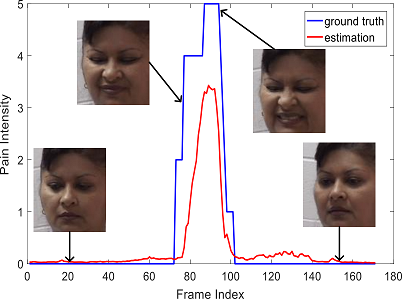Regularizing Face Verification Nets For Pain Intensity Regression
https://arxiv.org/abs/1702.06925
- My Caffe (https://github.com/happynear/caffe-windows/tree/ms). If you don't want to train with class-balance sampling (image_data_layer.cpp) and observing Pearson Correlation during training (correlation_loss_layer.cpp), you may use the official Caffe.
- Matlab,
- GPU with CUDA support,
- MTCNN face and facial landmark detector(https://github.com/kpzhang93/MTCNN_face_detection_alignment).
We uploaded some of the predicted values generated by our algorithm in /results. You may load them in Matlab and run scripts/get_accuracy.m to get the performance under various metrics.
-
Download the UNBC-McMaster Shoulder Pain Dataset(http://www.consortium.ri.cmu.edu/painagree/). Delete the black files in
095-tv095\tv095t1afaff. -
Download the pre-trained face verification model from Google Drive or Baidu Yun.
-
Detect and align the faces in the dataset by ./scripts/general_align.m.
-
Create list for Caffe's ImageData layer by ./scripts/create_list.m and ./scripts/create_sublist.m(For cross-validation).
-
Copy all the folders created by ./scripts/create_sublist.m to
./prototxt/and run ./prototxt/run_script.cmd.
It takes about 4-6 hours to train all 25-fold cross validation.
-
Use ./scripts/extract_feature.m to extract results from the 25-fold cross-validation (because I didn't write the logic when detector cannot find face in the image).
-
Get the performance by ./scripts/get_accuracy.m.
We encourage future works to use the new proposed evaluation metrics, wMAE and wMSE. The evaluation codes are in ./scripts/get_accuracy.m.
The model definition files used in EmotionNet Challenge are provided in ./prototxt/EmotionNet. Besides the details described in our submitted paper, we further used a novel technique called mirror face to encode the features both from frontal face and mirror face, in an end-to-end fashion. The details and analysis will be described in a comming journal paper.
To try the mirror face technique, you need to compile my Caffe (https://github.com/happynear/caffe-windows/tree/ms), or transplant the flip_layer to your own Caffe.
This code is distributed under MIT LICENSE
If you find these codes useful in your research, please cite
@inproceedings{wang2017regularizing,
title={Regularizing Face Verification Nets For Pain Intensity Regression},
author={Wang, Feng and Xiang, Xiang and Liu, Chang and Tran, Trac D and Reiter, Austin and Hager, Gregory D and Quon, Harry and Cheng, Jian and Yuille, Alan L},
booktitle={IEEE International Conference on Image Processing 2017},
year={2017},
organization={IEEE Xplore}
}
Feng Wang [feng.wff(at)gmail.com] or Xiang Xiang [xxiang(at)cs.jhu.edu]
(please replace (at) with @.)
